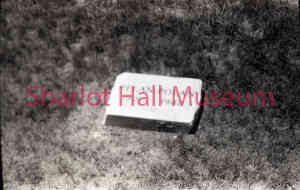Relan Polan Gravestone
details
Museum Staff Unknown c113pa.jpg C-113 B&W 1020-0113-0004 c113pa 35mm Negative <2x3 Historic Photographs c. 1984 Reproduction requires permission. Digital images property of SHM Library & ArchivesDescription
This photo shows the gravestone of Relan Polan (b. 1900 - d. 1942) in the Mountain View Cemetery
Mountain View Cemetery is located at 1051 Willow Creek Road in Prescott, AZ. Incorporated in February 1910 by Lester L. Ruffner, H.M. Maus, and J.M. Lovejoy. The Mountain View Cemetery Association began work on their project in March, laying out roads and paths and installing an irrigation system for the eighteen acre cemetery. Internments began in June. The association broke ground for a new marble mausoleum on May 18, 1916. Dedicated on December 17, 1916 the mausoleum was touted as the first to be constructed in the state.
NOTE: Many of the photos in this folder were very blurry and cannot be read. Therefore only a few of the photos have been placed on the website.
Purchase
To purchase this image please click on the NOTIFY US button and we will contact you with details
The process for online purchase of usage rights to this digital image is under development. To order this image, CLICK HERE to send an email request for details. Refer to the ‘Usage Terms & Conditions’ page for specific information. A signed “Permission for Use” contract must be completed and returned. Written permission from Sharlot Hall Museum is required to publish, display, or reproduce in any form whatsoever, including all types of electronic media including, but not limited to online sources, websites, Facebook Twitter, or eBooks. Digital files of images, text, sound or audio/visual recordings, or moving images remain the property of Sharlot Hall Museum, and may not be copied, modified, redistributed, resold nor deposited with another institution. Sharlot Hall Museum reserves the right to refuse reproduction of any of its materials, and to impose such conditions as it may deem appropriate. For certain scenarios, the price for personal usage of the digital content is minimal; CLICK HERE to download the specific form for personal usage. For additional information, contact the Museum Library & Archives at 928-445-3122 ext. 14 or email: orderdesk@sharlot.org.




